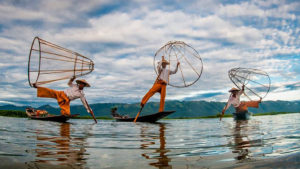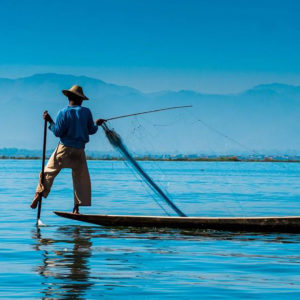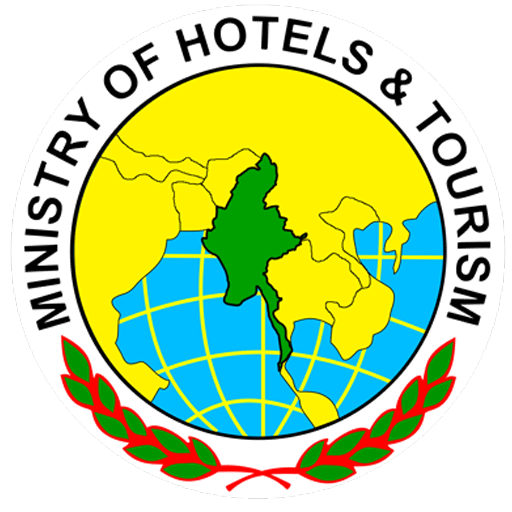Inle
Inle Lake – A Picturesque Natural Lake
 Inle Lake is in the middle of the southern part of Shan Plateau in eastern Myanmar. Covering 12,000 hectares (22 km long and 11 km wide), Inle Lake – a picturesque natural lake is the second largest natural lake in the country. Located 900m above sea level and surrounded by mountains, it has a comfortable temperature throughout the year. It is an ideal destination for travelers for its idyllic tranquility, waterfront villages, its market and its gardens on the water – a perfect place for a stopover of a few days during a stay in Burma.
Inle Lake is in the middle of the southern part of Shan Plateau in eastern Myanmar. Covering 12,000 hectares (22 km long and 11 km wide), Inle Lake – a picturesque natural lake is the second largest natural lake in the country. Located 900m above sea level and surrounded by mountains, it has a comfortable temperature throughout the year. It is an ideal destination for travelers for its idyllic tranquility, waterfront villages, its market and its gardens on the water – a perfect place for a stopover of a few days during a stay in Burma.
This picturesque natural lake is inhabited by Inthas that have adapted to their environment by building entire villages on stilts. It is a true lakeside jewel nestled in the heart of the mysterious mountains of the Shan plateau. You can conquer the lake in a canoe that will transport you to unsuspected landscapes with stilt houses, pagodas, floating gardens that undulate to the rhythm of the currents.
You will not get tired of admiring the lake in the early morning, with its blue opal water and the mountains that surround it. Silent fishermen as graceful as dancers add a touch of magic to this extraordinary picture. Every moment of the day is worth seeing; the landscape changes color and the sky is reflected in the lake, real mirror. In the morning, when the fog is very dense, the lake becomes mysterious. At noon, the light changes and this is another setting. The sky is pure blue and the lake surface reflects the color of the sky. In the evening when the sun disappears, the hills turn pink, the lake beams with golden highlights, fog comes back. This is not the lake that sparkles but the garlands of pagodas and the lights of the houses.
Intha fishermen
 The waters of Inle Lake are rich in fish and fishing is a major activity. The Inthas fishermen have a special technique to fish: as they move in boats they are maneuvering in a unique way in the world, standing on one leg on the back of their boat, they scull with a single oar around which they roll up the other leg. They catch fish using a conical trap they pose on the mud bottom. The elegance of their movements made the fishermen of Inle Lake one of the most enduring images.
The waters of Inle Lake are rich in fish and fishing is a major activity. The Inthas fishermen have a special technique to fish: as they move in boats they are maneuvering in a unique way in the world, standing on one leg on the back of their boat, they scull with a single oar around which they roll up the other leg. They catch fish using a conical trap they pose on the mud bottom. The elegance of their movements made the fishermen of Inle Lake one of the most enduring images.
Floating gardens
 At the lake surface, we see the floating gardens, which cover a quarter of the lake area. The Inthas have a special way to organize their gardens on the lake waters that rise and fall with the tides. Vegetable rely on a delicate carpet made of mud, water hyacinth and other plants. This assembly is secured with bamboo stakes driven into the water. The Inthas mainly grow tomatoes which are very popular, squash, cucumbers, potatoes and flowers that are sold in all markets of the country during the eight months of production.
At the lake surface, we see the floating gardens, which cover a quarter of the lake area. The Inthas have a special way to organize their gardens on the lake waters that rise and fall with the tides. Vegetable rely on a delicate carpet made of mud, water hyacinth and other plants. This assembly is secured with bamboo stakes driven into the water. The Inthas mainly grow tomatoes which are very popular, squash, cucumbers, potatoes and flowers that are sold in all markets of the country during the eight months of production.
Craft workshops
 One of interesting aspects of Inle Lake is the visits to craft workshops. Stop at Inpawkhone village to see the Intha’s traditional weaving method, especially the weaving of stems of lotus to make the unique fabric in the world. See how the colorful umbrella are made from tree bark, how cheroot- traditonal Burmese cigar are made by hand.
One of interesting aspects of Inle Lake is the visits to craft workshops. Stop at Inpawkhone village to see the Intha’s traditional weaving method, especially the weaving of stems of lotus to make the unique fabric in the world. See how the colorful umbrella are made from tree bark, how cheroot- traditonal Burmese cigar are made by hand.
Religious sites
The surroundings of Inle Lake are also dotted with archaeological and architectural wonders. As everywhere in Burma, we find here several pagodas and Buddhist monasteries plus the remarkable ruins in the villages of Sagar and Indein. Phaung Daw Oo is the main sanctury in this area, which houses five sacred Buddha image covered in gold leaf. Nga Phe Kyaung (or Jumping Cat Monatery), a wooden monastery built on stilts, also draws many attractions.
‘5-day’ market
 Furthermore, travelers are attracted by the markets that take place every fifth day in a different village near the lake. This is an opportunity to meet with Shan, Pa-O, the TaungYo, of Danu, the Kayah and Danaw exchanging their products, a colorful spectacle that you will not forget.
Furthermore, travelers are attracted by the markets that take place every fifth day in a different village near the lake. This is an opportunity to meet with Shan, Pa-O, the TaungYo, of Danu, the Kayah and Danaw exchanging their products, a colorful spectacle that you will not forget.
How to get there
The most convenient way to travel to Inle is by airplane, we landed at Heho Airport. You must then travel 35 km (about 45 minutes) on a mountain road to reach the village of Nyaungshwe, the gateway to Inle Lake.





